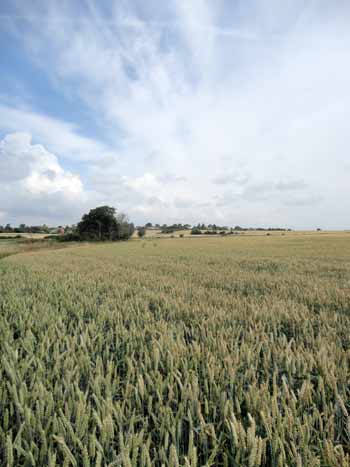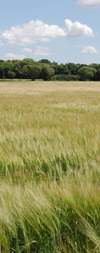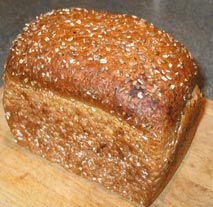A Healthy Cereal is a Wholegrain Organic One
What counts as a healthy cereal?
Cereals and grains play a large part in most people's diets. Cereals can be both nutritious and delicious. But which ones are best for our health? And which ones are grown in ways that do not harm the environment?
And how just much wheat should we be eating?

Picture: wheat growing in East Anglia, UK
This page is about the cereals we eat and how organic whole grains are the best cereal choice for everyday eating.
This is the first of several pages on healthy cereals and cereal nutrition facts. After a brief look at the role of cereals in our diets, this page considers wheat as a nutritional cereal. There is a brief history of wheat and a look at some of the health implications of modern cereal production methods.
There are enormous environmental concerns about our farming and cereal production methods. Modern farming is quite unsustainable because of the high energy inputs needed, in particular the high use of fossil fuels.
Ads and fads
We are bombarded with ads for breakfast cereals: "High fibre", "low fat", "added vitamins", "suitable for a calorie-controlled diet for weight loss", - the claims made for these creations are endless.
Whether many of them are actually "healthy cereals" is certainly debatable!

Some cereal manufacturers have deep pockets and seem to spend the equivalent of a small country's wealth on their advertising campaigns.
Many such cereals are not especially healthy cereals because they have been processed and denatured for the junk food market. They are nutritionally poor and some may even contain traces of pesticides and other contaminants. Many have added sugars which make them appealing to kids but nutritionally poor. Products such as these may be appealing as an occasional treat but are certainly not a good choice for daily fare.
As part of a green lifestyle you may want to eat mainly organic cereals and grains because they are better for your health and definitely better for the environment. You may also want to include a high percentage of whole grain foods (rather than refined cereal products) because they are generally nutritionally superior, especially to bleached and highly processed supermarket products.
"There is evidence that regular consumption of cereals, specifically wholegrains, may have a role in the prevention of chronic diseases…. People who consume diets rich in wholegrain cereals seem to have a lower incidence of many chronic diseases, e.g. coronary heart disease and type 2 diabetes."
- The British Nutrition Foundation
Healthy cereals for everyday nutrition
In this section we present some cereal nutrition facts about the different types of grain with notes about their nutritional benefits, what makes each a healthy cereal, and some tips for using and storing them most effectively.
We start with a look at whole grain wheat.
For more about organic foods please see Healthier diet advice and Why organic?
About wheat - a brief history
Wheat has had a long history of cultivation by mankind.
It was until very recently, the most popular grain in the world. It has been superseded by rice and maize, probably because they are more easily genetically modified.
There has also been a backlash in recent years against the over-consumption of wheat; the Atkin's diet and the higher profile of gluten allergies may be responsible. There are also nutritionists who advise against too much cereal in the diet because lectins may cause absorption difficulties with other nutrients. Lectins are naturally occurring proteins which are also found in legumes.
The wheat that we eat today bears little resemblance to wild kinds.
Wheat was discovered and developed by early farmers in the middle east. By about 11,000 years ago primitive strains were being crossed to produce better yielding crops.
Further mutations and crossing of strains led to more improvements from the point of view of the farmer. The grain became easier to thresh, for example (the separating the husks and chaff from the body of the grain).
Healthy cereal choices and cereal nutrition facts:
Biological mutations
Further changes occurred in the 1950s when Borlang caused biological mutations by bombarding wheat seeds with chemicals and radioactive isotopes.
The resulting wheat plant had a complex biological make-up: most wheats are "hexaploid", meaning that they have 6 sets of chromosomes. Around 90% of modern wheat grown is of this type.
This may be one reason wheat why the grain that causes the most allergic reactions and symptoms of food intolerance.
Modern types of wheat, (short-straw varieties) also contain lower amounts of crucial minerals such as iron, zinc and magnesium.
The molecules of modern wheat are large and difficult for the digestive system to process effectively. For people who are sensitive to wheat, a healthy wheat grain may be a spelt grain, or one of the other old strains of wheat which are now being researched and produced around the world.
Healthy cereal choices and cereal nutrition facts:
Wheat as an allergen
Wheat can often also provoke allergic responses because it is not organic. Wholewheat is, ironically, often more damaging in this respect because more pesticide residues remain after processing.
White flour has the hulls and chaff removed as well as the precious wheatgerm. Some of the pesticide residues found in non-organic wheat are therefore found in greater concentrations in wholewheat flour, where more of the outer parts are kept.
There are many people who are unable to digest wheat because of gluten intolerance. Scientists now think that coeliac disease affects as many as 1 in a 100 in Caucasian populations.
If you suffer from gluten intolerance you may need to cut wheat and other foods containing gluten from your diet. You can buy gluten-free breads and flours and lots of special supplies for people suffering from Coeliac disease. Here is a general-purpose flour based on fava beans, tapioca and chickpea, for example.
Coeliac disease results in damage to the small intestines and common symptoms can include: anaemia, weight-loss, bloating, pale diarrhoea, brittle bones, tiredness and even depression. (If you suspect you might suffer from this condition, see a doctor or other qualified health professional.)
Eating a lot of wheat might not be such a good idea for the rest of us, too. If you think about the amount present in many people's daily diet, you will see that it is perhaps a disproportionately large source of calories and nutrition.
Wheat is one of the principal allergens, probably largely because we (in the west) eat so much of it. In fact, even our animals are eating more of it; wheat production has doubled in the UK in recent years because of the unsustainable feeding regimens of many of our livestock. Cows are fed intensively-grown grains instead of their traditional diet of meadow grasses and herbs.
Modern wheats also contain enough WGA (wheat germ agglutinin) to cause health problems for many people - not just gluten-sensitive individuals. These lectins are found in the greatest amounts in wholewheat products and even in sprouted wheat. What do they do? They cause gut inflammation and suppress immune function. They may even help cause insulin resistance, thereby helping the onset of diabetes.
So it is perhaps advisable to keep wheat, especially the modern types, to a fairly minor part of our diets.
Healthy cereal choices and cereal nutrition facts:
So what's in wheat?
For most people, wheat can be a part of a healthy diet. Wheat flour and grains need to be cooked in order for our bodies to break down the cell walls to release the nutrients. You can eat soaked wheat berries raw - but it's a rather limited way of taking your wheat!
Many people swear by the health benefits of sprouted wheat and wheatgrass juice. If you eat some of your wheat in these forms, you will be certain of obtaining top quality nutrition.
Whole meal flour is rich in B vitamins, especially inositol, and calcium and iron.
All these can be relatively hard to find in a typical western diet. Inositol, which has a role in preventing hair loss, is manufactured in a healthy gut, but food sources are very desirable too.
Calcium is found in good quantities in milk and cheese but can be quite hard to absorb sufficiently from these sources. Many people, particularly teenagers and women are short of iron.
White bread and flour is enriched with calcium during production but it is lacking in other vitamins and minerals, especially potassium and iron.
It is also completely missing the valuable germ of the grain, which is rich in vitamin E as well as many of the B vitamins. B vitamins are really a complex of vitamins which work together well. For this reason, supplying only one or two of them, (as in many refined breakfast cereals) is only a very partial solution.
The food industry first removes the vitamins by processing and refining the cereal and then fortifies these nutritionally poor foods with added vitamins: these only partly replace what has been lost.
So, if you want to give yourself and your family the best nutrition, eat mainly wholegrain and organic wheat products, rather than highly refined ones. Explore other cereals and sources of carbohydrate, too.
Healthy cereals and digestion issues
It's worth taking time to work out just how well you process grains such as wheat. Our ability to digest even top quality organic grains may be limited and each individual needs to find out his or her tolerance. I know for myself that too many grains can be a challenge, especially if they are combined with protein foods.
Many nutritional authorities now encourage people to get their carbohydrate intake from vegetables and fruits rather than grains. It is clear that well selected grains can be beneficial but there are certainly limits to how digestible they are. As noted above, many people may be adversely affected by the WGA found in wheat, even top quality organic wheat.
I've reduced my own reliance upon bread and other wheat based foods with good results. Instead, I eat more vegetables and fruit and a selection of other grains in moderate amounts only. Of course, I lapse from time to time. I still enjoy making bread, for example and the occasional cake - but I always notice a decline in my energy if I have too much wheat.
Other types of wheat
Older kinds of wheat may be more digestible for many people. Consider spelt wheat or emmer wheat, for example. These are simpler at the molecular level and are less likely to trigger allergic responses. Spelt is itself a hybrid of the older emmer wheat. These both contain gluten so people with gluten intolerance will be unable to enjoy them. Emmer wheat is still popular in parts of Europe and can be found in supermarkets and health shops marketed as farro.
Einkorn wheat is another early wheat type which may hold more promise for coeliac sufferers, as the gliadin protein that it contains may be less allergenic than the gluten found in most wheats.
Spelt flour breads are now widely available in health food shops and farmers markets across Europe. It is more digestible than high-gluten wheat but still contains enough gluten to cause problems for coeliacs. It has a good rangee of vitamins and minerals, including high levels of B1, B3 and zinc.
Where can you buy organic whole grain flour and breads?

Organic wheat is now being grown more in Canada and the UK and elsewhere. There are also small artisan millers producing fine wholewheat flour from local grain. Some of their products even find their way onto supermarket shelves.
Most health food stores will stock a selection of organic wheat flours, including "spelt" flours. Some stores even stock wheat berries but this is unusual. People who make a lot of home-made bread sometimes like to use home-ground flour, too. It apparently has a finer flavour. You can buy suitable organic wheat for grinding to make flour and other purposes such as sprouting from Amazon.
Healthy cereal choices and cereal nutrition facts:
Storing your cereals for best nutrition
It's important to store your wheat flour carefully. Flour deteriorates and loses vitality the longer it is stored. Wheatgerm is especially liable to go rancid, as the natural oils become exposed to oxygen. Flours are best kept in an air-tight container in a cool but dry environment.
All things being equal, an organic cereal will be nutritionally superior to a conventionally produced one. But a stale cereal will have lost a lot of its nutritional goodness, even if it is a top-quality organic product.
Healthy cereals - some reading
Here are some good recipe books for cooking and baking with grains
Here are some great books on using grains as a healthy part of your diet. Healthy cereal choices can definitely be tasty!
Whole Grains Every Day, Every Way
This book features exceptionally tasty and yet simple recipes. There's no need to feel that you have to put up with eating heavy-going, dull-textured food just because you want to eat whole grains. these recipes are tried and tested and they deliver!
This book, as the title suggests, gives detailed information on cooking some of the more unusual grains. Quinoa, barley and farro and many others are becoming more common in the shops and open up a wealth of cooking and baking possibilities.
Desserts and entrées feature as well as main courses and there's a wealth of detail on the history and culture surrounding many of the grains.
Rebecca Wood goes into loving detail on many of the grains presented here. She has a background in macrobiotic cookery and understands the subtle flavours and harmonies which can be brought out in well-cooked grains as part of a complex and nourishing dish. There are recipes for amaranth and "Tef" as well as many staple grains.
Healthy cereal choices and cereal nutrition facts:
Other valuable cereals
Other valuable cereals which may be worth considering if you are trying to enrich and vary your diet include quinoa, millet and buckwheat. Amaranth grain is also increasing in popularity.
Amaranth is interesting as it is relatively easy to grow. I'm trying my hand at processing some at home though I suspect it may well be a bit too fiddly for anything other than a novelty home-grown food! There is a good description of how to process amaranth seeds on the Real Seeds website. This excellent company encourages seed saving and sells an interesting range of vegetable seeds adapted to the British climate.
I've grown buckwheat but, so far, only as a green manure. It is easy to grow and the seeds are easy to collect. It is not a type of wheat but is related to the very scary Japanese knotweed (famous for destroying foundations of buildings and devaluing houses).
*****
Sponsored links
Green Kitchen - Natural and Organic Foods
Greenfootsteps Home - for more easy green living ideas
| Tweet |

| Tweet |

On other pages
Other pages related to healthy cereals which may interest you:
A Healthy Low Fat Granola RecipeA Muesli Recipe for the Best Breakfast
For information on using and storing oats, their nutritional value and the different types available please see:
Oat Flour and Oat Groats - Oats Any Way You Like!
If you are interested in baking your own bread, check the recipes at
The whole grain bread recipe page
Footprints
- an occasional e-zine from Greenfootsteps
If you would like to receive the e-zine, please just sign up below.






New! Comments
Have your say about what you just read! Leave me a comment in the box below.